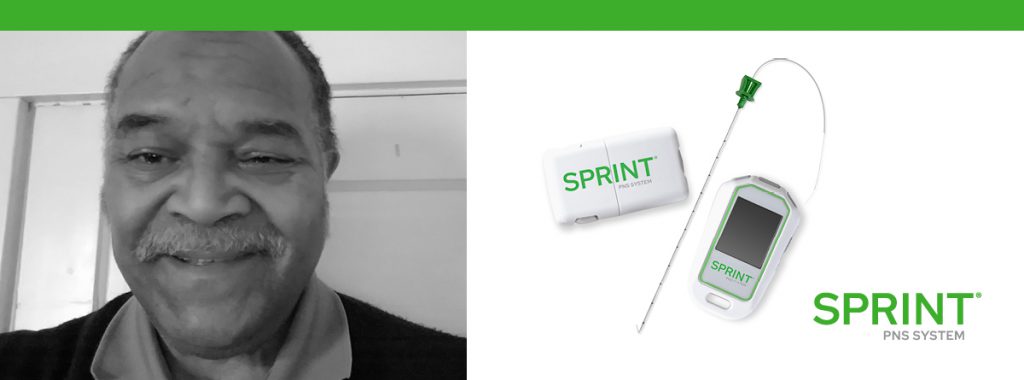Pain affects many people of all ages and in a variety of ways. Acute pain, chronic pain – both can develop in areas throughout the body as a result of injury, age, genetics and other health concerns, as well as vary in levels of severity.
In fact, in 2017 an article in The Atlantic reported on studies revealing that Americans experience more pain than those in any other country, with about a third of Americans reporting physical pain “often” or “very often.”
With such a prevalence of pain, treatment over the last few years has evolved from primarily being opioids (that can be effective but can also cause side effects and addiction) and surgeries to now also including temporary peripheral nerve stimulation (PNS) that is a less-invasive, temporary-device, proven to provide long-lasting pain relief.
To dive a little deeper, the following are three common pain syndromes and real-life stories about how SPRINT PNS can help with them.
Lower Back Pain
Low-back pain is one of the most common pain syndromes in America today, with 31 million Americans experiencing low-back pain at any given time. Moreover, it’s been found that low back pain is one of the leading causes of disability worldwide.
Back pain can be caused by a multitude of events including sprains or muscle strains, ruptured disks, irritated joints, accidents or injuries, arthritis, obesity, internal health issues (e.g. kidney stones) and even psychological stress. The back is a complicated physical structure that can be painful for a variety of reasons. Treating back pain often includes massage, stretching, physical therapy, medication, injections, nerve ablation and sometimes surgery. Studies have shown that for people with chronic low-back pain, SPRINT PNS offers an innovative pain relief treatment option that may help reduce the use of opioids and help patients avoid more invasive options.
Wayne’s Lower Back Pain Relief Story
Shoulder Pain
Often due to aging or injury where the soft tissues of the shoulder have broken down, shoulder pain is common today. In fact, following back and knee pain, shoulder pain is the third most common reason a physician is visited for pain-related concerns. Health.com estimated 67 percent of people experience shoulder discomfort at some point over their lifetime. Why is shoulder pain is so common? As one of the most mobile joints in the body – the shoulder is comprised of bones held in place by muscles, tendons and ligaments that work collectively together – it is also one of the most susceptible to injury. From everyday wear and tear on the rotator cuff tendons to joint arthritis, the shoulder can develop chronic pain in various ways.
Hank’s Shoulder Pain Relief Story
Hank suffered from chronic pain in his right shoulder for a couple of years. The pain, he said, ranged in severity from an 8 to a 10 depending on what he was doing. As a result, Hank saw decreased strength in his upper body and began to isolate himself away from others while trying to determine what was causing the pain. Then, Hank’s son, a pain management physician, told him about SPRINT PNS and suggested he explore it as an alternative to surgery. Watch how SPRINT PNS helped Hank return to a more active lifestyle without surgery and find sustained relief from his shoulder pain.
Knee Pain
Knee pain is the second most common cause of chronic pain, with around 15-20 percent of men and 20 percent of women afflicted with knee pain at some point throughout their life. Knee pain is especially problematic as it can restrict movement, negatively affect muscle control, cause reductions in strength and even result in injuries to other parts of the body compensating for the side where the knee pain occurs.

Rodney’s Knee Pain Relief Story
Chronic knee pain can be unbearable, and for some, it can occur after a total knee replacement surgery. TV actor Rodney Greene had this happen, and the pain in his left knee was so bad that when describing the severity of his pain on a scale of 0-10, he stated “I would say it was a 20 if you could rate it a 20 it was so bad”. Rodney opted to try SPRINT PNS for the pain that endured after his knee replacement surgery and he is now pain free.
How SPRINT PNS Can Help
Depending on the severity of pain and where the pain is located, various treatment methods may be recommended. Pain conditions vary, and the above are only a few of the those that PNS can help with.
When it comes to creating a treatment plan, the SPRINT PNS System marks an innovative shift in treating pain by offering a minimally invasive and drug-free option. SPRINT PNS is a 60-day treatment that has been proven to provide significant and sustained relief from chronic pain. It works by specifically stimulating targeted peripheral nerve fibers within the area where the pain is located, and it has been studied extensively to provide relief for low back pain, shoulder pain, post-amputation pain and chronic post-operative pain.
If you’re experiencing pain and you’d like to learn more about how SPRINT PNS works to treat pain, click here.
If you’re a physician interested in learning how SPRINT may fit within the pain treatment care continuum in your practice, click here to find more information and see how the device works.
*Results may vary. Important safety & risk information: https://www.sprtherapeutics.com/physicians/important-safety-information/
Sources:
[1] https://www.acatoday.org/Patients/What-is-Chiropractic/Back-Pain-Facts-and-Statistics/Back-Pain-Facts-and-Statistics
[2] http://www.thelancet.com/themed/global-burden-of-disease
[3] https://www.health.com/condition/pain/shoulder-pain-causes

